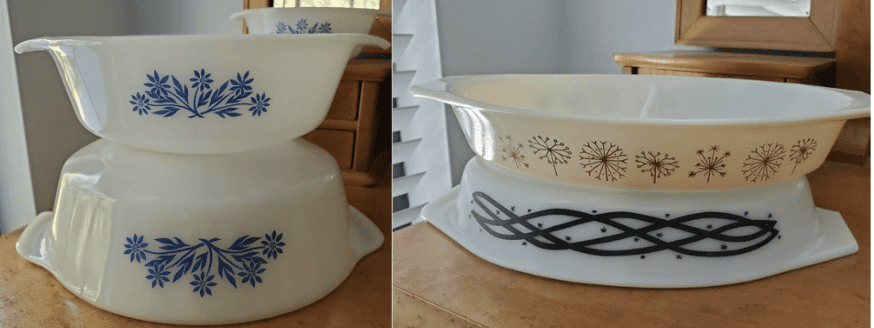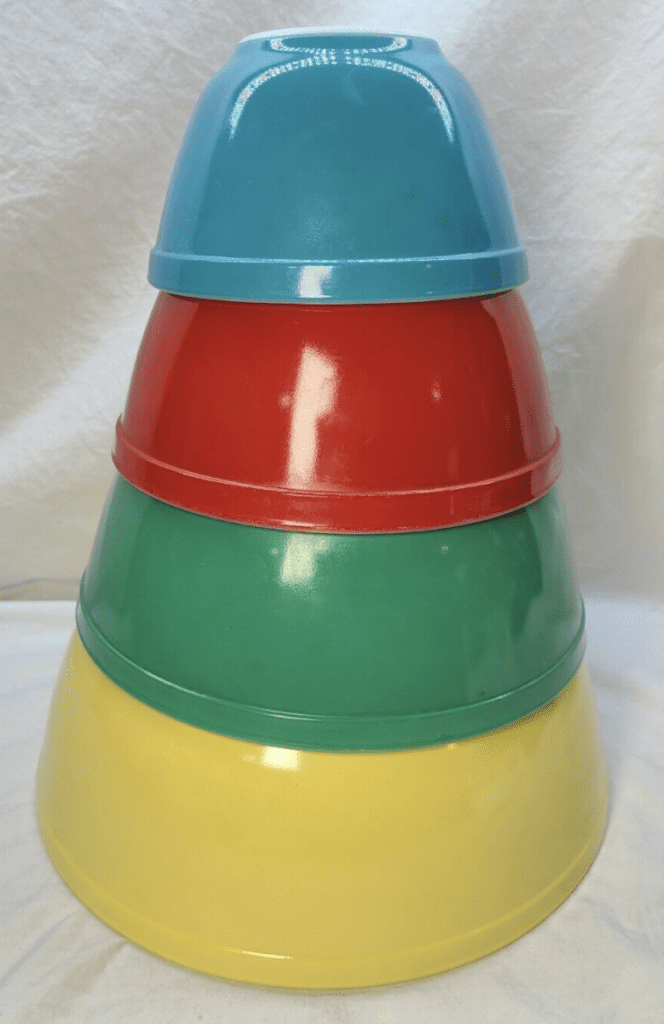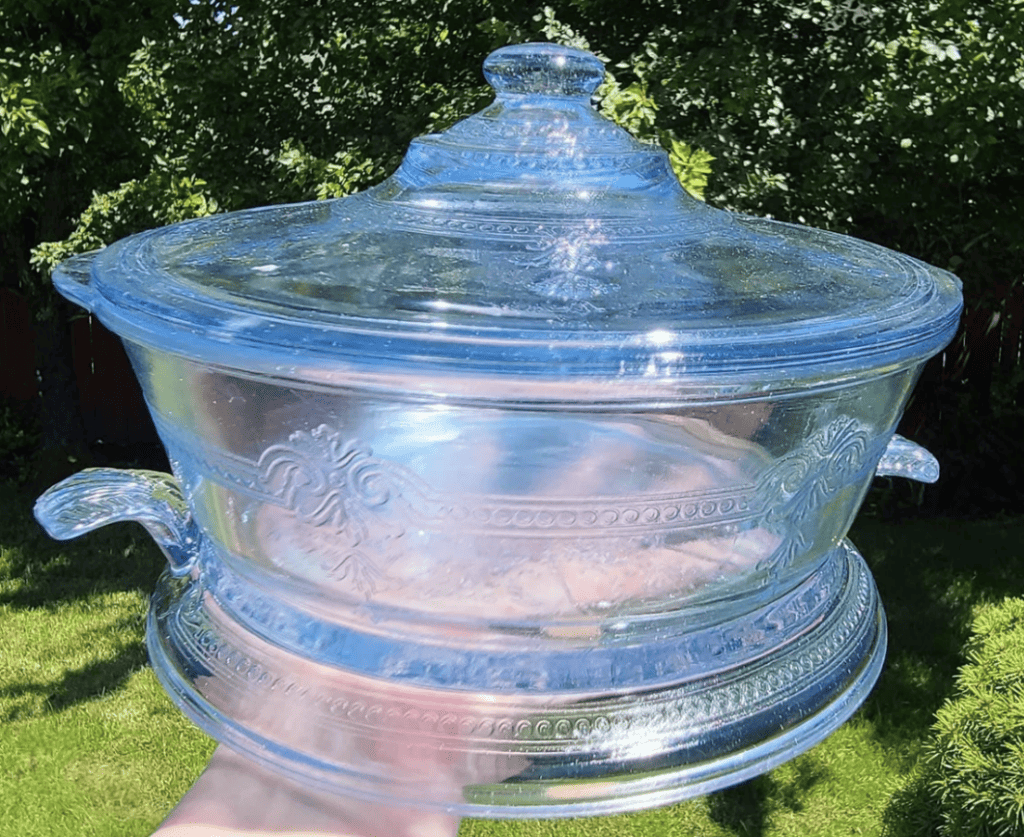Pyrex was introduced as a brand early in the 20th century by a glassworks company called Corning Incorporated. While the Pyrex brand was originally focused on using glass for kitchenware, it has also been used in telescopes. The Fire-King brand, on the other hand, came into the market in the mid-20th century, and it delved deeply into all types of kitchenware.
Pyrex and Fire-King are not the same. Both glassworks started as low-expansion borosilicate glass, but they have evolved into better types of glass. Pyrex now uses soda-lime glass, as well as other materials. Fire-King also uses soda-lime-silicate glass, rather than the borosilicate it became popular for.
So, how else do both brands differ? And in what ways are they similar? Let’s delve into the differences between Pyrex, the original borosilicate glass, and Fire-King, the upstart.

Are Fire-King and Pyrex the same?
No, but there are some similarities. Both brands were once made with borosilicate glass and seen as fire-proof. They’re still used for baking in ovens today, but they could potentially shatter from heat if you’re not careful. The soda-lime glass allows both glasswares to reach oven temperatures of about 425 degrees. However, if they are heated up too quickly, like on a stovetop, they could shatter!
Which is older: Fire-King or Pyrex?
The Pyrex brand came into the market in 1915. At the time, the bulk of glass used in America was Duran, which was a German brand. Due to the first World War, Pyrex quickly became the local alternative to Duran, and it gained popularity.

Sold for $114.90 from baxbuys on Ebay
By the 1940s, Pyrex started to focus seriously on producing different types of glassware for the kitchen. In 1943, the iconic set of primary color mixing bowls was introduced to the market, and after them came different types of dinnerware and dishes. Pyrex also introduced a collage of brilliant colors with their wares, including pink, red, and yellow.
Around the time Pyrex ventured into kitchenware, Fire-King entered production in 1942 and became established under Hocking Glass Corporation. The kitchenware blossomed in popularity, thanks to its opaque glasses and beautiful patterns. Glassware made from Fire-King’s jadeite glass was perhaps the brand’s most popular, and they made everything, from cups to saucers, using jadeite.

Is Fire-King as good as Pyrex?
While this is a matter of personal opinion, Pyrex was arguably the better and much bigger brand for many decades. Although the founding company has entered other fields outside glassware, Pyrex glass remains a popular household item in many parts of the world.
As far as quality, both brands have used similar glass types over the decades. They both made the switch from borosilicate to soda-lime, and they have maintained a strong focus on glass durability.
Fire-King vs Pyrex: Popular vintage patterns
Pyrex started with clear glass, only pushing towards colorful kitchenware in the 1940s. These colorful designs became exclusive to the brand name, and today, these are what collectors look out for.
Popular Pyrex patterns
- Snowflakes: white snowflake patterns
- Butterprint: scenes on a farm, depicting roosters, plants, and people.
- Gooseberry: berries on vines with a leafy design.
- Town and Country: abstract star-like designs.
- New Dot: large dots patterned on white.
- Friendship: orange patterned roosters.
- Butterfly Gold: floral patterned with white and gold.
- Autumn Wheat: sheaves of wheat.
Related: Vintage Pyrex Pattern Guide
Popular Fire-King patterns
- Jadeite: opaque, light-green, and popular.
- Peach Lustre: colorful, iridescent peach.
- Primrose: limited series in pink and red flowery designs.
- Meadow Green: patterned leaves.
- Wheat: patterned wheat in gold and silver.
- Forget Me Not: blue Forget Me Not flowers.
- Fleurette: pink flowery designs.
- Shell: shell-based patterns in different colors.
- Sheaves of Wheat: similar to Wheat, but interlocking sheaves.
- Alice: floral design in Vitrock and Jadeite.
- Fish Scale: scaly pattern.
Which is more valuable: Fire-King or Pyrex?
Although it is similar to Pyrex, Fire-King isn’t a high-end collectible like some Pyrex wares. It is possible to find a rare Fire-King glass set worth a serious amount of money, but more often than not, these are hardly available for sale.
Jadeite, a very popular green glassware by Fire-King, has seen low-end prices over the years. It is possible to find saucers for less than $5 apiece, while dinner plates can cost around $10 to $15 apiece. Larger items and sets of items like mixing bowls can be worth several hundred dollars.

Fire-King’s Jadeite Restaurant Ware items are more expensive across the board. The coffee mugs from this particular set will set you back by as much as $100 apiece. The white version is even more expensive, starting at around $250 apiece. If you find an older, rarer Restaurant Ware piece, you may have to part ways with upwards of $300.
These items are only a little cheaper than Fire-King’s Sapphire Blue pieces. These are high in value, with a set of mixing bowls costing around $75. More common pieces can be found in the $20 to $30 range, and some are even cheaper. Sapphire Blue custard cups can cost as low as $5 per piece. More intricate and rarer designs are bound to cost as high as $200, like Fire-King’s notable Philbe pattern.

Pyrex pieces are more valuable across the board than Fire-King. However, much of the value is dependent on desirability. For example, a vintage set of Pyrex custard cups may hardly cross the $5 mark, a multicolored mixing bowl can cost more than $50.
Particular Pyrex items have garnered the collector’s attention over the years, especially patterned Pyrex. The Lucky In Love bowl, made in 1959, has been valued at around $4,000 due to its rare four-leaf clover pattern. Another impressive pattern, the Blueprint from 1957, can be purchased for up to $500.

With Pyrex, it is possible to get a collection for as high as a few hundred dollars, while single items can be worth up to $100. Compared to Fire-King, Pyrex is valued higher in the antique market.
Conclusion
These two different brands have remained a vital part of kitchenware over the last century. Pyrex evolved into colorful designs for their glassware, and Fire-King followed closely behind. Many of these vintage glass sets were made, from saucers to cups and dinner plates, and a good number have survived.
While these brands are still in the market today, their main attraction was their vintage pieces, many of which were made with borosilicate glass. Their more recent offerings of soda-lime glass have been less desirable and hardly worth a collector’s time.
Finding vintage kitchenware in great condition is possible, especially with some of the more common patterns, which are quite cheap. However, there are still rare sets, like black polka-dotted Fire-King nesting bowls, which can go for over $200.
While their patterns took American kitchens by storm for decades, Fire-King and Pyrex remain very different brands. They’re not the same, certainly not to a collector, but they both offer beautiful glassware for any collection.

